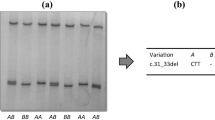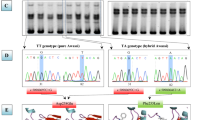Abstract
Purpose
The BMPR1B and BMP15 genes are well known for their considerable associations with prolificacy in sheep. These genes may also affect fertility or prolificacy in other species, including human. This study was conducted to investigate possible causative mutations in BMPR1B and BMP15 genes in human and an indigenous breed of sheep.
Methods
Blood samples were collected from 83 singleton- and prolific Mehraban ewes and 81 infertile, singleton- and twin-bearing women. A 190-bp fragment, containing the FecB mutation in ovine BMPR1B, a 380-bp fragment in ovine BMP15 gene and their homologous fragments in human were amplified and then investigated by single-stranded conformation polymorphism and DNA sequencing methods.
Results
The FecB mutation of BMPR1B (g.159A>G) was detected in the sheep population, but no polymorphic loci were found in the homologous fragment in studied human samples. The studied fragments of BMP15 were monomorphic in both sheep and human samples. A total of nine and 69 point-differences in the studied fragments of BMPR1B and BMP15 genes were detected between the species, respectively. In sheep, the G allele of BMPR1B had a positive effect on litter size (p<0.05), whereby all AG or GG ewes were prolific.
Conclusion
The FecB mutation for the first time was detected in Mehraban sheep and therefore could be considered for marker-assisted selection in this breed. The studied fragments of BMPR1B and BMP15 genes are not responsible for reproduction variation in human. More studies on other genes, associated with fertility in human, are necessary in the future.









Similar content being viewed by others
References
Davis GH. Major genes affecting ovulation rate in sheep. Genet Sel Evol. 2005;37:11–23.
McNatty KP, Moore LG, Hudson NL, Quirke LD, Lawrence SB, et al. The oocyte and its role in regulating ovulation rate: a new paradigm in reproductive biology. Reprod. 2004;28:379–86.
Abdoli R, Zamani P, Mirhoseini SZ, Ghavi Hossein-Zadeh N, Nadri S. A review on prolificacy genes in sheep. Reprod Domes Anim. 2016;51:631–7.
Elvin JA, Yan C, Malsuk MM. Oocytes-expressed TGF-beta superfamily members in female fertility. Mol Cell Endocrinol. 2000;159:1–5.
Driancourt MA, Cahill LP, Bindon BM. Ovarian follicular populations and pre-ovulatory enlargement in Booroola and control Merino ewes. J Reprod Fertil. 1985;73:93–107.
Mulsant P, Lecerf F, Fabre S, Schibler L, Monget P, et al. Mutation in bone morphogenetic protein receptor-IB is associated with increased ovulation rate in Booroola Merinos ewes. Proc Natl Acad Sci USA. 2001;98:5104–9.
Smith P, Hudson NL, Corrigan KA, Shaw L, Smith T, et al. Effects of Booroola gene (FecBB) on body mass, testis development and hormone concentrations during fetal life. J Reprod Fertil. 1996;108:253–61.
Patiño LC, Walton KL, Mueller TD, Johnson KE, Stocker W, et al. BMP15 mutations associated with primary ovarian insufficiency reduce expression, activity, or synergy with GDF9. J Clin Endocrinol Metab. 2017;102:1009–19.
Monteagudo LV, Ponz R, Tejedor MT, Lavina A, Sierra I. A 17 bp deletion in the bone morphogenetic protein 15 (BMP15) gene is associated to increased prolificacy in the Rasa Aragonesa sheep breed. Anim Reprod Sci. 2009;110:139–46.
Barzegari A, Atashpaz S, Ghabili K, Nemati Z, Rustaci M, et al. Polymorphisms in GDF9 and BMP15 associated with fertility and ovulation rate in Moghani and Ghezel sheep in Iran. Reprod Domest Anim. 2010;10:666–9.
Kasiriyan MM, Hafezian SH, Hassani N. Genetic polymorphism BMPI5 and GDF9 genes in Sangsari sheep of Iran. Int J Genet Mol Biol. 2010;3:31–4.
Zamani P, Nadri S, Saffaripour R, Ahmadi A, Dashti F, et al. A new mutation in exon 2 of the bone morphogenetic protein 15 gene is associated with increase in prolificacy of Mehraban and Lori sheep. Trop Anim Health Prod. 2015;47:855–60.
Nadri S, Zamani P, Ahmadi A. Novel mutation in exon 1 of the BMP15 gene and its association with reproduction traits in sheep. Anim Biotechnol. 2016;27:256–61.
Talebi R, Seighalani R, Qanbari S. A handmade DNA extraction kit using laundry powder; insights on simplicity, cost-efficiency, rapidity, safety and the quality of purified DNA. Anim Biotechnol. 2019;32:388–94.
Sanguinetti CJ, Dias Neto E, Simpson AJG. Rapid silver staining and recovery of PCR products separated on polyacrylamide gels. Biotechniques. 1994;17:914–21.
SAS Institute. Users Guide, Version 9.4: Statistics. Cary, NC, USA: SAS Institute; 2013.
Souza CJL, MacDougall C, Campbell BK, McNeilly AS, Baird DT. The Booroola (FecB) phenotype is associated with a mutation in the bone morphogenetic receptor type 1 B (BMPR1B) gene. J Endocrinol. 2001;169:R1–6.
Guan F, Liu SR, Shi GQ, Yang LG. Polymorphism of FecB in nine sheep breeds or strain and its effects on litter size, lamb growth and development. Anim Reprod Sci. 2006;99:44–52.
Moore RK, Shimasaki S. Molecular biology and physiological role of the oocyte factor, BMP15. Mol Cell Endocrinol. 2005;234:67–73.
Hanrahan JP, Gregan SM, Mulsant P, Mullen M, Davis GH, et al. Mutations in the genes for oocyte derived growth factors GDF9 and BMP15 are associated with both increased ovulation rate and sterility in Cambridge and Belclare sheep (Ovis aries). Biol Reprod. 2004;70:900–9.
Bodin L, Di Pasquale E, Fabre S, Bontoux M, Monget P, et al. A novel mutation in the bone morphogenetic protein 15 gene causing defective protein secretion is associated with both increased ovulation rate and sterility in Lacaune sheep. Endocrinology. 2007;148:393–400.
Demars J, Fabre S, Sarry J, Rossetti R, Gilbert H, et al. Genome-wide association studies identify two novel BMP15 mutations responsible for an atypical hyper prolificacy phenotype in sheep. PLoS Genet. 2013;9:e1003482.
Shabir M, Ganai TA, Misra SS, Shah R, Ahmad T. Polymorphism study of growth differentiation factor 9B (GDF9B) gene and its association with reproductive traits in sheep. Gene. 2013;515:432–8.
Amini HR, Ajaki A, Farahi M, Heidari M, Pirali A, et al. The novel t755c mutation in BMP15 is associated with the litter size of Iranian Afshari, Ghezel, and Shal breeds. Arch Anim Breed. 2013;61:153–60.
Abdoli R, Zamani P, Deljou A, Rezvan H. Association of BMPR-1B and GDF9 genes polymorphisms and secondary protein structure changes with reproduction traits in Mehraban ewes. Gene. 2013;524:296–303.
Talebi R, Ahmadi A, Afraz F, Sarry J, Woloszyn F, et al. Detection of single nucleotide polymorphisms at major prolificacy genes in the Mehraban sheep and association with litter size. Ann Anim Sci. 2018;18:685–98.
Abdoli R, Mirhoseini SZ, Ghavi Hossein-Zadeh N, Zamani P. Screening for causative mutations of major prolificacy genes in Iranian fat-tailed sheep. Int J Fertil Steril. 2018;12:51–5.
Duffy DL, Montgomery GW, Hall J, Mayne C, Healey SC, et al. Human twinning is not linked to the region of chromosome 4 syntenic with the sheep twinning gene FecB. Am J Med Genet. 2001;100:182–6.
Luong HTT, Chaplin J, McRae AF, Medland SE, Willemsen G, et al. Variation in BMPR1B, TGFRB1 and BMPR2 and control of dizygotic twinning. Twin Res Hum Genet. 2011;14:408–16.
Regan SLP, Knight PG, Yovich J, Stanger J, Leung Y, et al. Dysregulation of granulosal bone morphogenetic protein 1 receptor 1B density is associated with reduced ovarian 2 reserve and the age-related decline in human fertility. Mol Cell Endocrinol. 2016;425:84–93.
Renault L, Patiño LC, Magnin F, Delemer B, Young J, et al. BMPR1A and BMPR1B missense mutations cause primary ovarian insufficiency. J Clin Endocrinol Metab. 2020;105:1449–57.
Rossetti R, Di Pasquale E, Marozzi A, Bione S, Toniolo D, et al. BMP15 mutations associated with primary ovarian insufficiency cause a defective production of bioactive protein. Hum Mutat. 2009;30:804–10.
Demirhan O, Türkmen S, Schwabe GC, Soyupak S, Akgül E, et al. A homozygous BMPR1B mutation causes a new subtype of acromesomelic chondrodysplasia with genital anomalies. J Med Genet. 2005;42:314–7.
Acknowledgments
The authors thank to Bu-Ali Sina University for supporting and providing the facilities needed for this research.
Funding
This research was funded by Bu-Ali Sina University, Hamedan. Iran.
Author information
Authors and Affiliations
Contributions
Conducting experiments: PZ, FR, and EH. Analyzing and discussing data: PZ, RA, AA and SR. Writing manuscript: PZ, FR, EH, and RA. All authors read and agreed to the published version of the manuscript.
Corresponding author
Ethics declarations
Conflicts of interest
The authors declare no conflicts of interest.
Additional information
Publisher’s note
Springer Nature remains neutral with regard to jurisdictional claims in published maps and institutional affiliations.
Rights and permissions
Springer Nature or its licensor (e.g. a society or other partner) holds exclusive rights to this article under a publishing agreement with the author(s) or other rightsholder(s); author self-archiving of the accepted manuscript version of this article is solely governed by the terms of such publishing agreement and applicable law.
About this article
Cite this article
Zamani, P., Rabiei, F., Hadiei, E. et al. Screening for causative mutations in ovine BMPR1B and BMP15 genes and their homologous fragments in human. J Assist Reprod Genet 40, 1973–1982 (2023). https://doi.org/10.1007/s10815-023-02865-1
Received:
Accepted:
Published:
Issue Date:
DOI: https://doi.org/10.1007/s10815-023-02865-1




